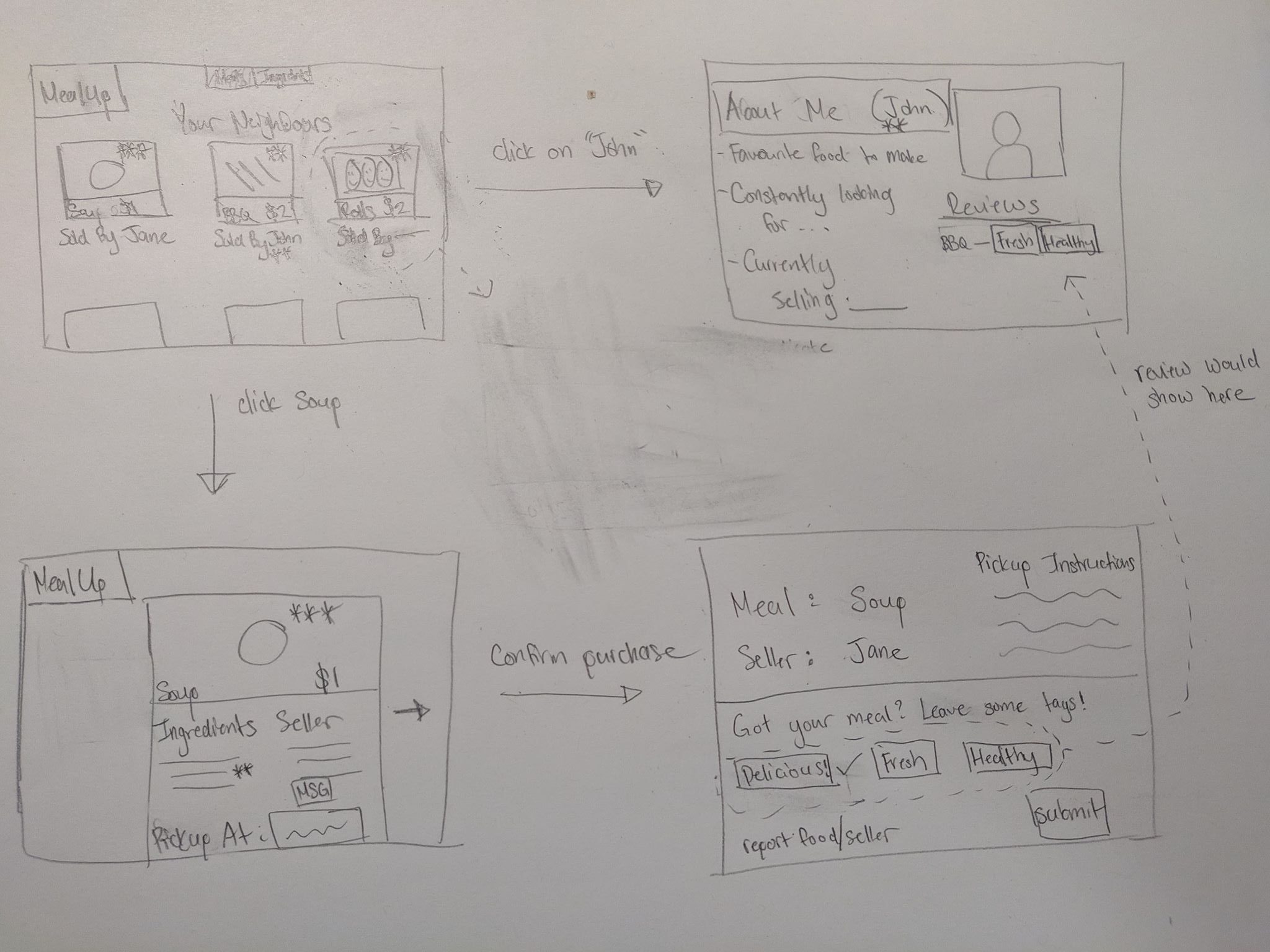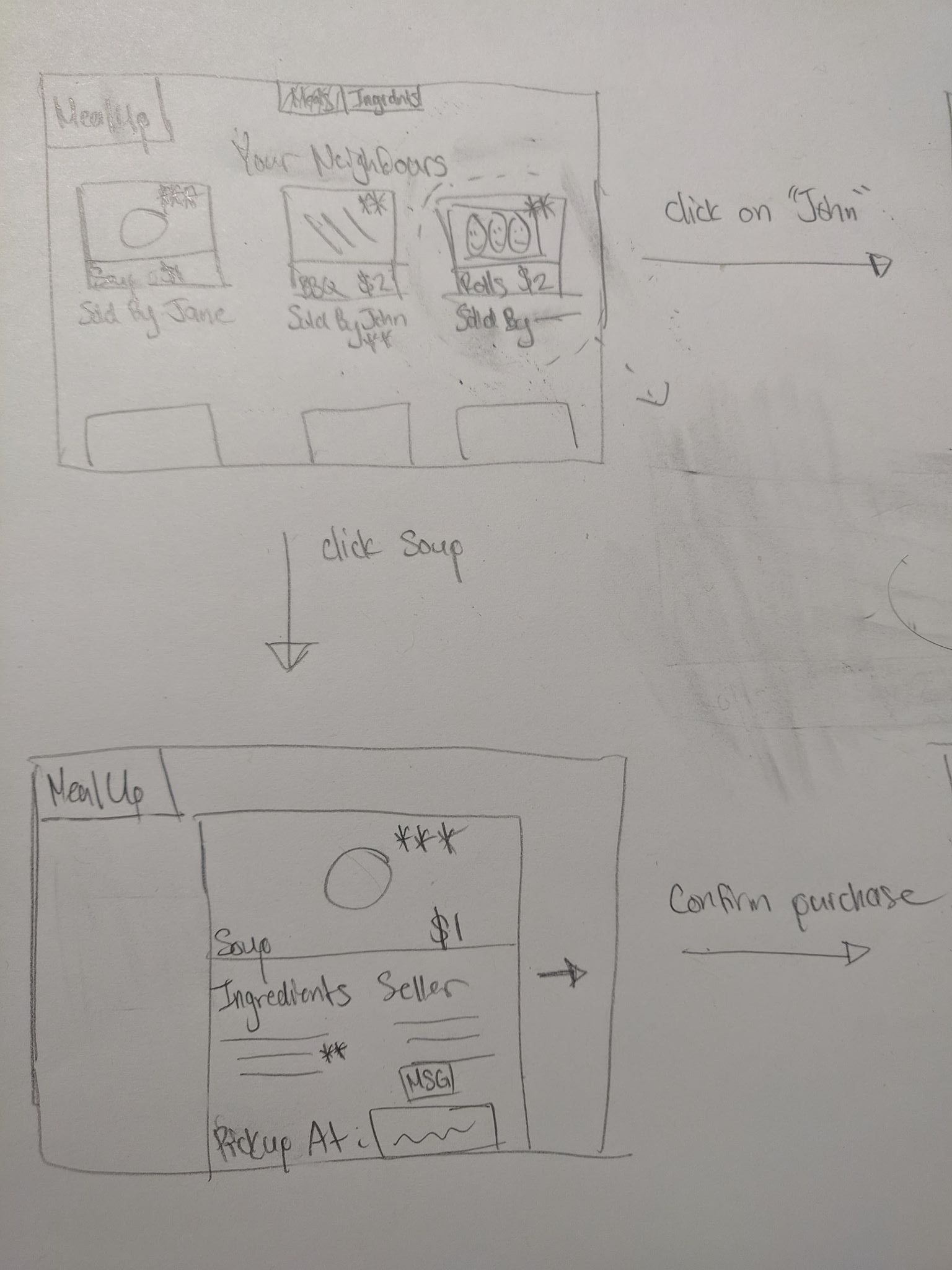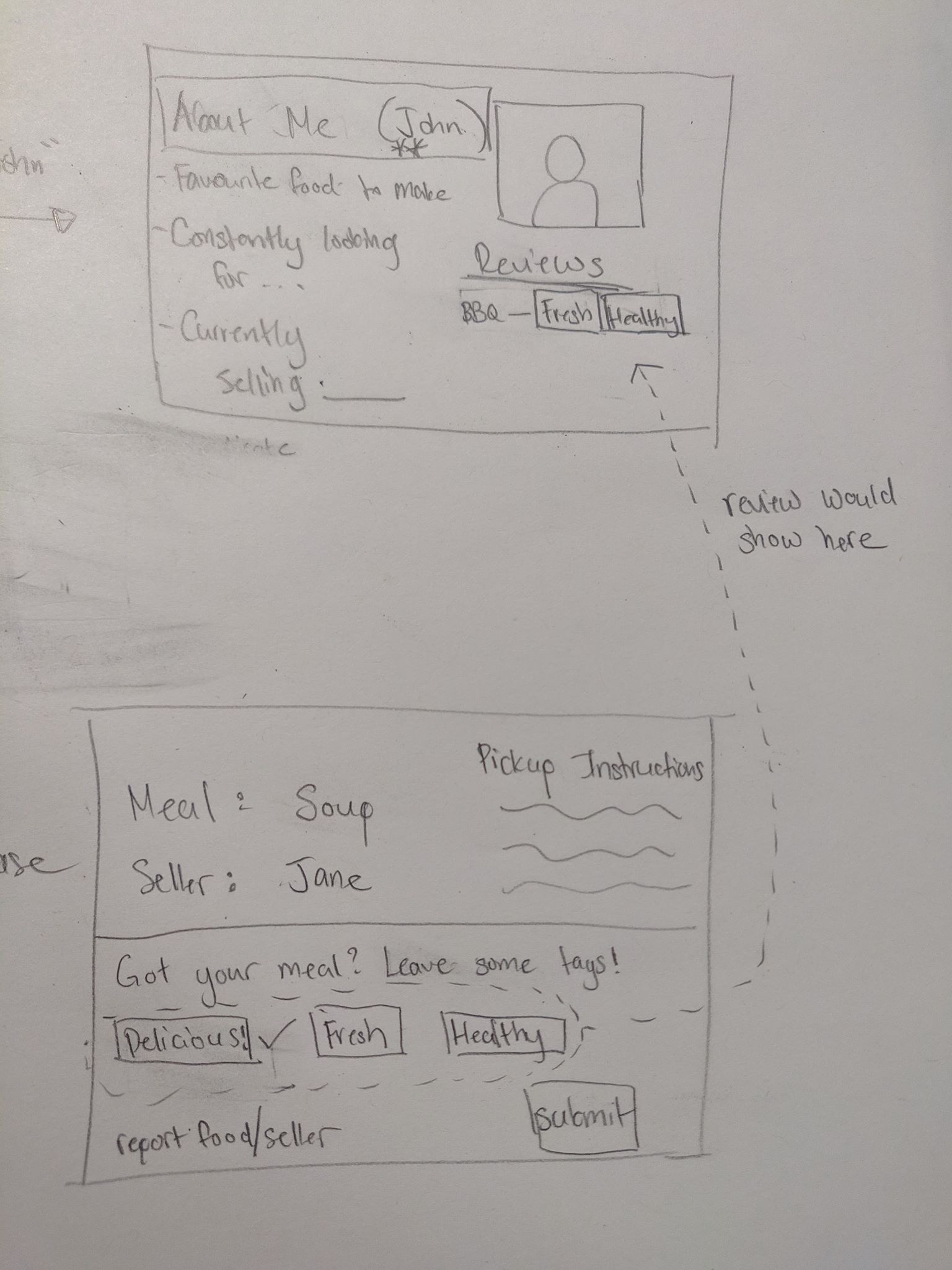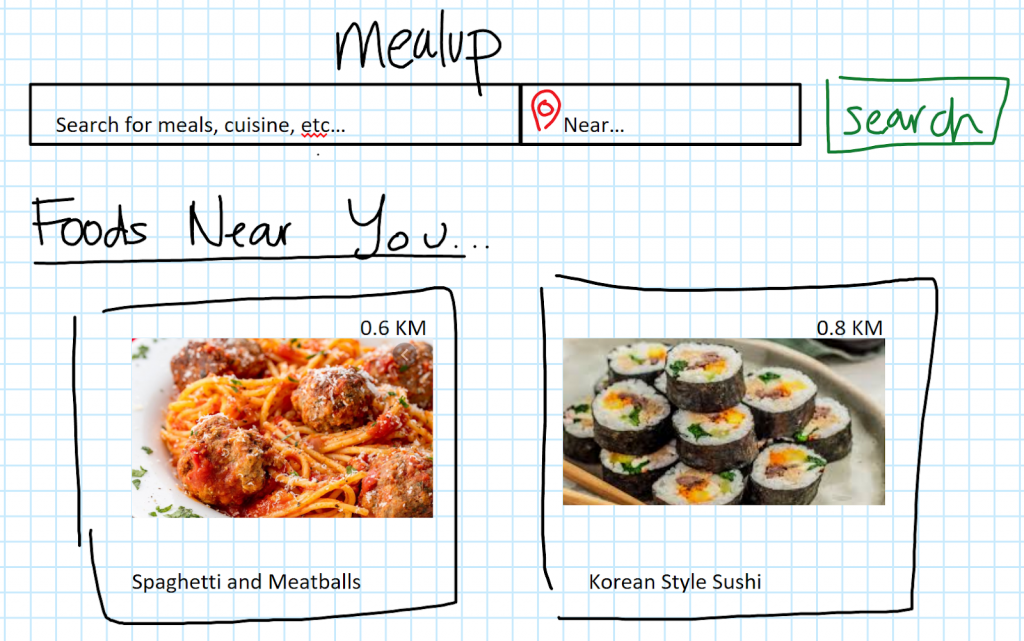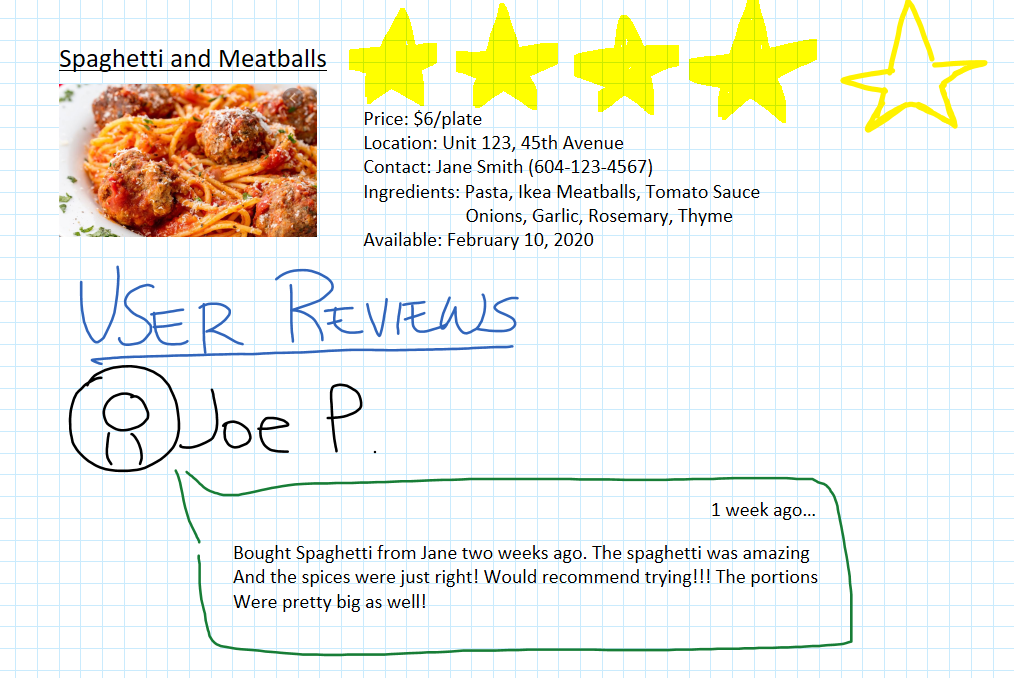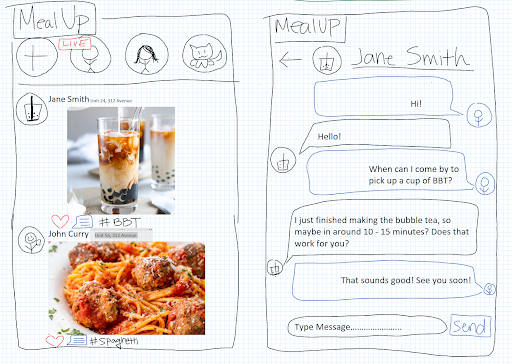Revised goals of experiment
- Evaluate what features of a posting can help increase trust for a potential consumer
- Evaluate whether users prefer having an interface that allows them to scroll through a list of available items or an interface that shows all the users registered for the apartment with their current status
- Evaluate which of the above interfaces performs more efficiently at browsing both specific food postings and neighbors
One takeaway from our field study was that participants who have little interaction with their neighbors generally have a low level of trust with one another. Our first goal is to help us understand what kind of information should be shared to increase trust between users. We will be evaluating this goal through analyzing multiple features such as, attaching pictures of the food in the posting versus not attaching a picture, viewing an user with a completed profile versus a partially completed profile.
Our second goal is to help us better understand how to design our main page in order to display important visual information. A simple design option we have is to list only items and persons that are active. Although this option considerably cuts down on info onscreen, we feel that this layout hinders the ability to visualize their community in a salient way. As such, we aim to evaluate the subjective preference of the list interface against an interface that maps more closely to the building.
Our third goal will look at whether there is a difference in efficiency between a layout that organizes building community by room versus one that displays just active listings and active persons. This will help to inform us about any possible tradeoff in efficiency brought on by emphasizing community in a way that does admittedly introduce more clutter.
Experiment method
Participants
We aim to recruit 12 participants overall, taking a purposive sampling approach to recruitment. A representative sample of the population living in apartment buildings (or similar co-living complexes such as condos or townhouses) will be chosen. Those living in student dorms will be excluded, as findings from our field study mostly indicate either a lack of interest or lack of capacity for this kind of food sharing in temporary residences such as dorms.
Conditions
Our study will consist of two experiments, each with two tasks. All 12 participants will complete all four tasks.
Experiment 1 will be comparing two different components of our interface: food posts and user profiles. For each component, we will be assessing the level of trust the participant perceives given the amount of information (Low, High) contained in each.
The main difference between the low and high level of information category of the food posts is that the high food post contains a longer description, an ingredients list, and a separate dietary notes section. Additionally, the description also mentions that the user is looking to make friends and willing to share or trade food. For the low food profile, the dietary notes section is mixed in with other hashtag labels.
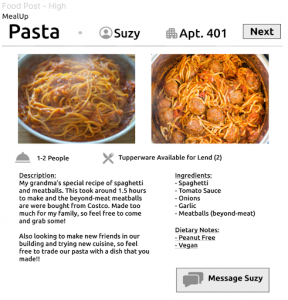

As for the profiles, the main difference between the low and high level of information profiles is that for the high profile, the user uses a real picture, contains the user address, has an awards/trophy section and shows mutual friends.
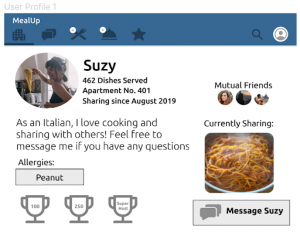
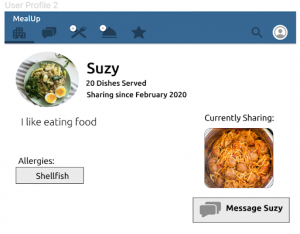
Experiment 2 will compare the efficiency and overall satisfaction between two distinct layouts for the main page of our interface. The two layouts that we will be evaluating are the apartment view and the list-view layouts.
For the apartment view, the layout will be designed to mimic the layout of an apartment, specifically being organized in floors and enabling the user to browse other users on a specific floor. Additionally, each user may visually indicate that they are looking for food, marked with a “hungry!” (red box in picture below) indicator next to their profile, or post a food dish that is available that is indicated with a picture of their food (green box in picture below).
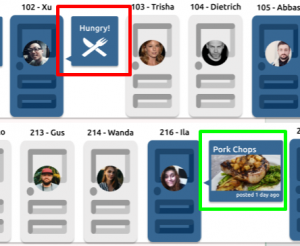
The list view will be simpler and straightforward, featuring two headings that indicate both users who are looking for food and food postings that are currently available.
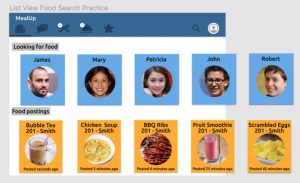
Experimental Tasks
Experiment 1:
Meal Selection Process Task – this task consists of two parts: comparing between a high/low level of information for food posts, and comparing between a high/low level of information for user profiles. After each part, the participant will be asked to respond to a survey after each comparison.
Experiment 2:
Person-targeted task – For each of the two main page layouts, the participant will be prompted to find a person on a specific floor that is looking for food. For each trial, the screen will feature different people and food listings that the participant will have to search for. Once each trial is completed, an intermediate screen will show for 3 seconds that will prompt the participant for the next trial. An example prompt would say “Find any person living on the 3rd floor who is looking for food”.
Food-targeted task – For each of the two main page layouts, the participant will be prompted to locate a specific food listing. Each listing will be specified only by their name. Like with the person-targeted task, the screen will feature different people and food listings that the participant will have to search for. This task will also utilize an intermediate screen. An example prompt will say “Find the food listing for tomato soup”.
The ordering between these two tasks will also be counterbalanced between participants, but the participant will always complete the food listing task and user profile task before starting the person-targeted task and the food-targeted task.
Design
Our study consists of two 2×2 within-subjects factorial designs. The first experiment consists of two levels of food postings (Low, High) and two levels of profiles (Low, High). The second consists of two levels of apartment layout (spatial vs list) and two different tasks (person-targeted search vs food-targeted search).
Procedure
Actual procedure may vary in order due to counterbalancing of conditions. The following is one example:
Experiment 1
- Participant will have 2 minutes to to read through a basic user profile and task description.
- Participant will perform the meal selection process task.
- Participant will complete a survey.
Experiment 2
- Participant will have 3 minutes to familiarize themselves to both the spatial-view and list-view layouts of the application.
- Participant will perform the person-targeted task after one practice trial.
- Participant will perform the food-targeted task after one practice trial.
- Participant will complete a survey regarding their experience with both layouts. The survey will help to gather information about which interface was more desirable.
Apparatus
The experiment will be conducted in different project rooms around the UBC campus. The basic profiles and task description will be printed and given to the participants, and the actual tasks will be conducted on a provided tablet.
Variables
Independent variables
Experiment 1
- Profile (Levels: Low, High – within-subjects)
- Food Posts (Levels: Low, High – within-subjects)
Experiment 2
- Layout (Levels: Spatial, List – within subjects)
- Search Task (Levels: Person-centered, food-centered – within-subjects)
Dependent variables
Experiment 1
User Trust Level – using a Likert scale to record data and determine the level of trust the participant has with different food posts and user profiles (with different levels of information). The participant will fill out their preferences after the completion of the first task.
Experiment 2
Average time to complete – for each task, the average amount of time between trials will be calculated. The time for each trial will be recorded in a spreadsheet and verified by reviewing the video recording session.
User satisfaction – after completing both tasks, the participant will report their satisfaction with a brief survey that includes six Likert scale questions, and a question asking about which layout they overall prefer.
Control Variables
Experiment 1
Order of interfaces – will be counterbalanced
Order of information level – will be counterbalanced
Experiment 2
Order of layout – will be counterbalanced
Order of search task – will be counterbalanced
Hypotheses
Participant Trust Level
H1: Higher levels of trust for user profiles with higher levels of detail will be reported than those with lower levels of detail.
Null: There will be no difference in the reported values for trust between the two user profiles.
H2: Higher levels of trust for food posts with higher levels of detail will be reported than those with lower levels of detail.
Null: There will be no difference in the reported values for trust between the two food posts.
Layout
H3: There is a difference in the time spent in performing (search tasks) between the two layouts.
Null: There will be no difference in the time spent in performing (visual search tasks) between the two layouts
H4: There will be a difference in the reported desirability between the two layouts.
Null: There will be no difference in the reported desirability between the two layouts.
Planned statistical analyses
For experiment 1, we will be using ANOVA (Analysis of Variance) to test the difference of means between ratings, information level, and profile vs food post.
For experiment 2, we will use analysis of variance (ANOVA) to test the difference in means between search time and the overall satisfaction between the two layouts. We will mainly be looking at whether the layout has a main effect, but we will also determine if there is an interaction effect between layouts and tasks. The ordering of the tasks and of the layouts will also be considered.
Expected limitations of the planned experiment
For experiment 1, our task would not be a realistic situation since the participant will not be going through the normal flow of the interface to get to these pages. Additionally, the participant will not be able to message the other party to develop trust between each other, which may affect the findings of our analysis, since actual users of our interface can develop trust in other ways than just the amount of information given.
In regards to experiment 2, while it is reasonable to assume that a user will want to search for both food and other users who are looking for food, we did not provide a way to filter information or perform the task based on a criteria. For example, it is likely a user would want to find meals that are suitable for a vegetarian diet. Another way to filter through postings could be to provide times in which a person will specifically be looking for food, allowing a user to plan ahead on when they will desire food. However, since a visual search forms the basis of these activities, it will still provide useful evidence for which layout is most efficient and desirable. Future research should be conducted on how to best implement some of the features listed above.
